Red-eared slider turtle
Trachemys scripta elegans
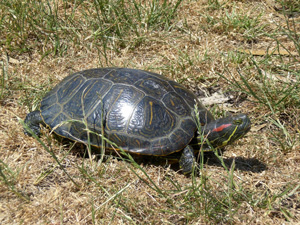
Have you seen this animal? Report it now!
Photos and accurate descriptions of where and when the animal(s) was sighted are critical when making a report. Detailed information allows the Victorian Government to make a timely and positive identification. All reports are responded to as a priority and may result in trapping, surveillance and the removal of confirmed Red-eared slider turtle.
It's important to report red-eared slider turtle sightings
The red-eared slider turtle is not native to Australia. It is a very adaptable and opportunistic invasive animal that has the ability to populate a wide range of fresh water ecosystems. They compete with native turtles for:
- food
- basking sites
- nesting sites
- suitable habitat.
Red-eared slider turtle are classified as a controlled pest animal under the Victorian Catchment and Land Protection Act 1994. The importation, keeping, breeding and trading of this species, without appropriate permits, is illegal and penalties apply.
Red-eared slider turtles have been found in the wild in Victoria. They have been removed from Elsternwick Park Lake, the Yarra River and from several locations in urban streets of Melbourne. The department has also conducted a trapping program in the Moorabool River at Fyansford to help prevent breeding of a confirmed animal in this location.
The red-eared slider turtles found in Victoria are most likely an escapee or deliberately released animal from the illegal pet trade. The illegal keeping of red-eared slider turtles poses one of the greatest risks of the species establishing in Victoria. Escapees or deliberately released animals can be extremely difficult and costly to recover.
How to identify a Red-eared slider turtle
Size
The red-eared slider turtle is a medium-sized fresh water turtle with an adult carapace (shell) length of 12.5 to 28 cm.
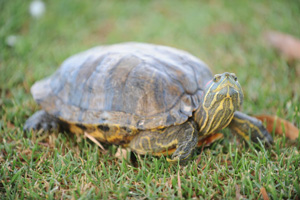
Colour
The carapace (shell) is dark green in colour with sometimes yellow and black markings as circular blotches.
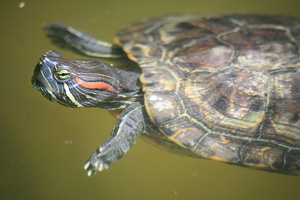
The plastron (underside) is bright yellow with black rings, blotches and swirls marking each of the 12 segments.
Red-eared slider turtles in the wild will often have a thick layer of algae covering their shell whereas escapees from captivity are often clean and brightly coloured.

Distinctive features
They have a broad red or orange stripe behind each eye with narrow yellow stripes marking the rest of the black body, neck, legs and tail.
Their shell is dome-shaped, likened to the shape of a helmet.
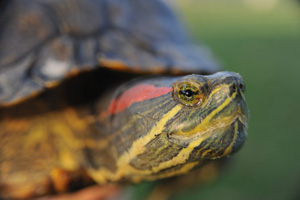
They have distinctive long claws on their front and hind legs. The claws are longer and more prominent in males than females.
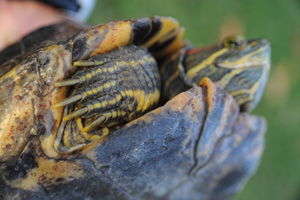
They retract their head straight back into their shell when threatened. Native turtles tuck their neck to one side underneath the shell.
Habitat
They can tolerate a wide range of habitats and are sometimes found in estuaries and coastal wetlands with brackish water. They can also tolerate a range of water quality and accept high levels of organic pollutants such as effluent and inorganic pollutants.
Behaviour
They are almost entirely aquatic, but as they are cold-blooded, they leave the water to sunbathe (also referred to as basking) to regulate their temperature. At night they rest on the bottom beneath the water or float at the surface. They are less active over the winter months.
Similar looking native turtles
Red-eared slider turtles may be confused with the native turtle species Eastern long-necked turtle (Chelodina longicollis) or the Murray River short-necked turtle (Emydura macquarii).
Before making a report of a red-eared slider turtle, use the information in native or exotic turtle to check the features of the specimen you have sighted and compare the identification characteristics that set the native turtles apart from the red-eared slider turtle.
If still in doubt, email photographs to highrisk.invasiveanimals@agriculture.vic.gov.au or contact our Customer Service Centre on 136 186, with details of the animal and a member of staff will contact you.
Impact on native species
The red-eared slider turtle have several attributes that give them a competitive advantage over native species such as:
- their larger adult size
- their aggressive nature
- high reproductive rate.
They can also carry exotic diseases and parasites which can be transmitted to native wildlife.
Acknowledgments
(i) Nightryder84 (Own work) [CC BY-SA 3.0 (http://creativecommons.org/licenses/by-sa/3.0)], via Wikimedia Commons
(ii) Laszlo-photo ([1]) [CC BY 2.0 (http://creativecommons.org/licenses/by/2.0)], via Wikimedia Commons